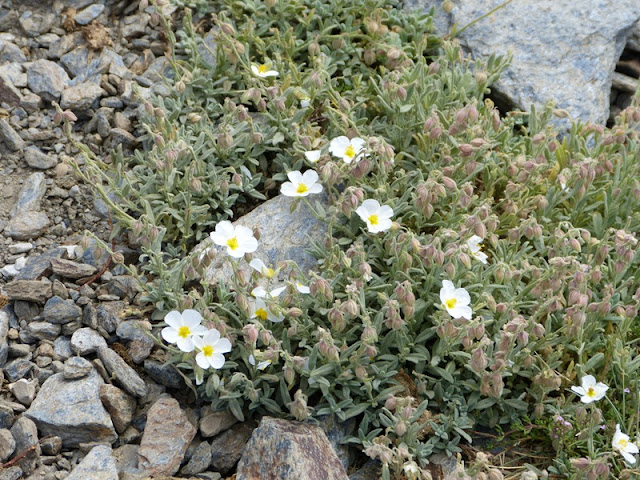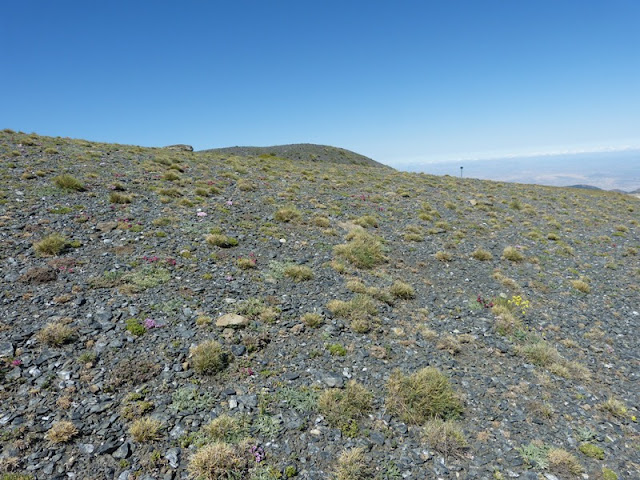There are various areas of our ground that I have tried to enhance for butterflies over the last four or five years. I know that this is quite a contentious subject, as habitats constantly evolve – grasslands turning into scrub, scrub turning into woodland and even woodland evolves from birch and rowan trees through to oaks. Each of these habitats is valuable but we often tend to favour one stage over another.
There has been a big push in this part of Scotland to plant trees, but this is often to the detriment of other species. Quite a number of sunny banks where wildflowers once grew are now planted with trees. Even if such areas are left unplanted, then without being grazed they can often be taken over by bracken, heather or thick grasses.
As I have discovered, it takes a lot of work to keep an area frozen in time! Here is an update on some of the projects I have previously written about.
I continue to have to cut the vegetation under the trees annually. Last year the grass cutter was broken down and it is amazing how many small beech, sycamore and willow trees are growing up. I usually leave this until after the first frosts in the hope that any caterpillars will be deep in the grass. The topper is set at about 5 inches, so it still leaves a good cover. The intention with these areas is to predominantly have grassland with wild flowers growing in it.
The area that was a spruce plantation has really greened up well. The spruce were very dense and there was no vegetation growing under them. This is the third year since they were felled and initially there were a lot of annual plants such as woodland groundsel. Last year there were hundreds of foxgloves, which are biennials, and this year there is a lot of grass cover, but also still plenty of wildflowers. The 13 species of native broadleaved trees I planted have mostly reached the top of their tree tubes and there is quite a bit of elder growing between them.
I am seeing a gradual improvement in my wildflower meadow over the years. The ground there appears to be quite fertile, so had a lot of nettles and thistles growing in it, as well as thick, rank grasses. The scythe mower has made a real difference by cutting the grass below the thatch, revealing the soil, which has allowed the wild flowers to come through. I then rake off the hay and pile it up at the side of the meadow. I had left some areas uncut for several years, but they were taken over by wild raspberries and I noticed willow trees seeding in there, so this winter I cut these areas down too. I have also taken off the lower branches of some of the surrounding trees, which will allow a lot more light in. It is interesting that wild flower plugs that I planted two years ago, which I thought had died, have reappeared this year.
Not long after we moved here I was standing at the top of the drive looking at all of the rhododendron growing all over the place. I thought to myself that if I didn’t start removing this invasive species it would soon take over the whole place. My wife and I have put a lot of work into removing it and I have sown wildflower seeds where it was. Although it must provide some shelter birds don’t tend to nest in it, the leaves are toxic and apparently the nectar is toxic to bees, it spreads quickly preventing other plants from growing, it can also host a fungus which kills oak and larch trees. So it is a plant that I am keen to remove. There are still acres of it to get rid of and I want to plant something like holly to provide shelter and nesting spaces.
And here is a picture I took from the same spot today.
One of my smaller projects was a bit of an experiment to see if I could get rockrose to grow on a bank close to the house. I took cuttings from wild plants further up the valley and have successfully produced ten healthy plants. These were planted out four years ago and have done well. Two years ago I was amazed to see a Northern Brown Argus in the garden. This year I saw another Northern Brown Argus, but this one was closer to the rockrose. It stayed around for a few days and later I spotted eggs on the rockrose, so it looks as though I may have my own mini colony of Northern Brown Argus. So, next spring I will take a lot more cuttings and hope to expand the area of rockrose.
The wildflower meadow is in quite an exposed area, so I decided to plant a mixed hedge almost six years ago. You would think it would be a good solid hedge by now, but sadly events conspired to restrict its growth! First the neighbour put cattle in his field and they just reached over the fence and pulled up the young plants! An electric wire prevented that happening again, but later his sheep managed to push the fence over and they gave the hedge a good prune! Initially I used plastic spirals to protect the young plants, but they were inadequate to stop rabbits and deer eating the plants. So, I invested in some wide shrub tubes. With a new sheep-proof boundary fence the hedge has done well this year for the first time!
The hedge is a mix of hawthorn, blackthorn, crab apple, hazel, guelder rose and alder buckthorn. These were mostly chosen because they will provide flowers and fruit for wildlife. Alder buckthorn is the food plant of the caterpillars of Brimstone butterflies and although the butterfly doesn’t exist in Scotland, other than the odd visit, I hope that one day a passing Brimstone may find my plants! This has actually sparked off a project that I will write about in a future post.
A lot of work has gone in to all of these projects, but it has all been very enjoyable and rewarding.


.jpg)
.jpg)
.jpg)
.jpg)



.jpg)
.jpg)
.jpg)
.jpg)
.jpg)
.jpg)
.jpg)

.jpg)


.jpg)

.jpg)
.jpg)
.jpg)
.jpg)
.jpg)

.jpg)

.jpg)
.jpg)
.jpg)





















